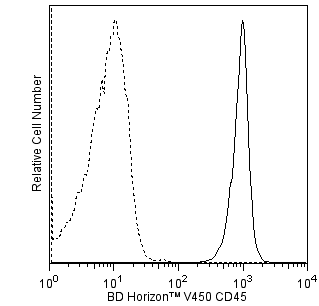Old Browser
Looks like you're visiting us from {countryName}.
Would you like to stay on the current country site or be switched to your country?


.png)

Flow cytometric analysis of CD59 expression on rat bone marrow cells. Bone marrow cells from a Lewis rat were stained with a BD Horizon™ V450 Mouse Anti-Rat CD45 antibody (Cat. No. 561587) and with either an APC Mouse IgG1, κ Isotype Control (Cat. No. 555751, dashed line histogram) or an APC Mouse Anti-Rat CD59 antibody (Cat. No. 562103, solid line histogram). Flow cytometric fluorescence histograms were derived from events gated on CD45-negative cells. Flow cytometry was performed using a BD™ LSR II Flow Cytometer System.
.png)

BD Pharmingen™ APC Mouse Anti-Rat CD59
.png)
Regulatory Status Legend
Any use of products other than the permitted use without the express written authorization of Becton, Dickinson and Company is strictly prohibited.
Preparation And Storage
Product Notices
- Since applications vary, each investigator should titrate the reagent to obtain optimal results.
- An isotype control should be used at the same concentration as the antibody of interest.
- Please refer to www.bdbiosciences.com/us/s/resources for technical protocols.
- Caution: Sodium azide yields highly toxic hydrazoic acid under acidic conditions. Dilute azide compounds in running water before discarding to avoid accumulation of potentially explosive deposits in plumbing.
- This APC-conjugated reagent can be used in any flow cytometer equipped with a dye, HeNe, or red diode laser.
- For fluorochrome spectra and suitable instrument settings, please refer to our Multicolor Flow Cytometry web page at www.bdbiosciences.com/colors.
Companion Products



The TH9 antibody monoclonal antibody specifically binds to CD59, a 21 kDa glycosyl-phosphatidyl inositol-anchored cell-surface glycoprotein of the Ly-6 superfamily. CD59 is expressed by many types of non-hematopoietic cells. In the rat hematopoietic system, CD59 has been detected on erythrocytes, monocytes, and some lymphocytes, but not on platelets. Soluble CD59 is found in body fluids and urine. CD59 is a complement regulatory protein that acts late in the complement cascade to prevent formation of the membrane attack complex (MAC). Therefore, CD59 is one of several proteins whose function is to protect host tissue from complement attack. Rat CD59 binds rat and human complement components and inhibits cytolysis mediated by complement from multiple species. CD59 has also been suggested to be a ligand for CD2 and to participate in T-cell costimulation.

Development References (6)
-
Funabashi K, Okada N, Matsuo S, Yamamoto T, Morgan BP, Okada H. Tissue distribution of complement regulatory membrane proteins in rats. Immunology. 1994; 81(3):444-451. (Biology). View Reference
-
Hughes TR, Piddlesden SJ, Williams JD, Harrison RA, Morgan BP. Isolation and characterization of a membrane protein from rat erythrocytes which inhibits lysis by the membrane attack complex of rat complement. Biochem J. 1992; 284(1):169-176. (Immunogen). View Reference
-
Lehto T, Morgan BP, Meri S. Binding of human and rat CD59 to the terminal complement complexes. Immunology. 1997; 90(1):121-128. (Biology). View Reference
-
Liversidge J, Dawson R, Hoey S, McKay D, Grabowski P, Forrester JV. CD59 and CD48 expressed by rat retinal pigment epithelial cells are major ligands for the CD2-mediated alternative pathway of T cell activation. J Immunol. 1996; 156(10):3696-3703. (Clone-specific: (Co)-stimulation, Stimulation). View Reference
-
Rushmere NK, Tomlinson S, Morgan BP. Expression of rat CD59: functional analysis confirms lack of species selectivity and reveals that glycosylation is not required for function. Immunology. 1997; 90(4):640-646. (Biology). View Reference
-
Sugita Y, Masuho Y. CD59: its role in complement regulation and potential for therapeutic use. Immunotechnology. 1995; 1(3-4):157-168. (Biology). View Reference
Please refer to Support Documents for Quality Certificates
Global - Refer to manufacturer's instructions for use and related User Manuals and Technical data sheets before using this products as described
Comparisons, where applicable, are made against older BD Technology, manual methods or are general performance claims. Comparisons are not made against non-BD technologies, unless otherwise noted.
For Research Use Only. Not for use in diagnostic or therapeutic procedures.
Report a Site Issue
This form is intended to help us improve our website experience. For other support, please visit our Contact Us page.